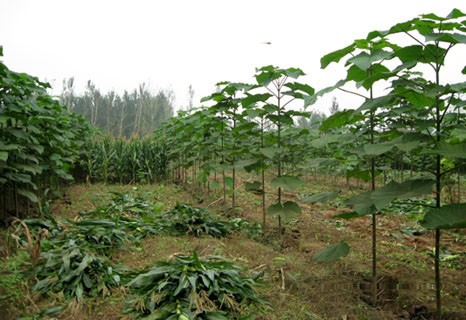Types of Paulownia Afforestation
Afforestation types are obviously different from each other owing to terrain types, soil conditions, land utilization and afforestation purposes in different areas. There are five afforestation types for Paulownia, which are suitable for different terrain, soil, geographic conditions and business purposes. Each area shall choose one of these types according to its actual situation.
Fast Growing And High Yield Paulownia Forest Giving Priority To Forest
Based on characteristics of being in favor of light, fertilizer, water, deep layer of soil and fast growing, land suitable for growing of Paulownia in the plain farming areas, coastal sandy areas, gentle slope hills, around towns and villages, as well as in the valley with deep layer of soil and terraced fields on the bottom of a mountain shall be selected for Paulownia afforestation land, where a pure forest mode known as high returns by high investment will be implemented to acquire the most and best timber within the shortest period.

Paulownia Artificial Forest Giving Priority To Both Farming And Forest
In the plain farming areas and areas along banks of river severely damaged by sandstorm should ensure stable farming yields depending on windproof & sand fixation measures, which reform the simplified planting structure, meanwhile develop Paulownia artificial forests in the purpose of forestry production.
Intercropped Forest Giving Priority To Farming
This is a new type of production structure combining farming with forestry and giving priority to farming, which is also the major style of developing Paulownia production in plain farming areas of China. Intercropping Paulownia on the farmland will not only weaken the wind speed by which dramatically reduce evaporation discharge of the soil water, but also moderate the air temperature, usually shows as cooling in summer and warming in winter. Especially facing to sudden increase and decrease of temperature, Paulownia intercropped forest will moderate the temperature remarkably, which plays an important role in improving field microclimate, ensuring stable yield and high yield, and enhancing the economic benefit. Meanwhile, Paulownia growth is also effectively promoted because of living in the farmland with advantageous water and fertilizer conditions and under careful management. The practice showed that there is a positive relationship between Paulownia growth and farmland yield where the higher farmland yield is, the faster of the Paulownia growth will be.
Small Piece Of High-Yield Paulownia Forest
This is a Paulownia afforestation mode utilizing small pieces of lands around the house, on edge of the field, near the village, along the road, on the dam and bank. Such a mode will not only make full use of the spared lands in small pieces, but also show the fast-growing characteristic of Paulownia due to favorable conditions, deep layer of soil and easy access for management of these lands. So, we can acquire timber within a short period and also improve and beautify environment under this mode. Paulownia will be planted dispersedly and mostly in rows or irregular small pieces if plants with this mode.
Paulownia Mixed Forest
To build mixed Paulownia forest with other tree species in a proper manner will not only improve the afforestation quality, make full use of the soil fertility, increase economic yield per unit area and improve site conditions, but also prevent a high incidence of diseases and insect pests.
In addition to building mixed forest with other tree species, shade-enduring plants such as shade-enduring bush, herb and vegetable could be planted in the forest as well. Special breeds also could be done in the forest for various fowls and insects, where their food chains will emerge in the relatively independent forest environment.
